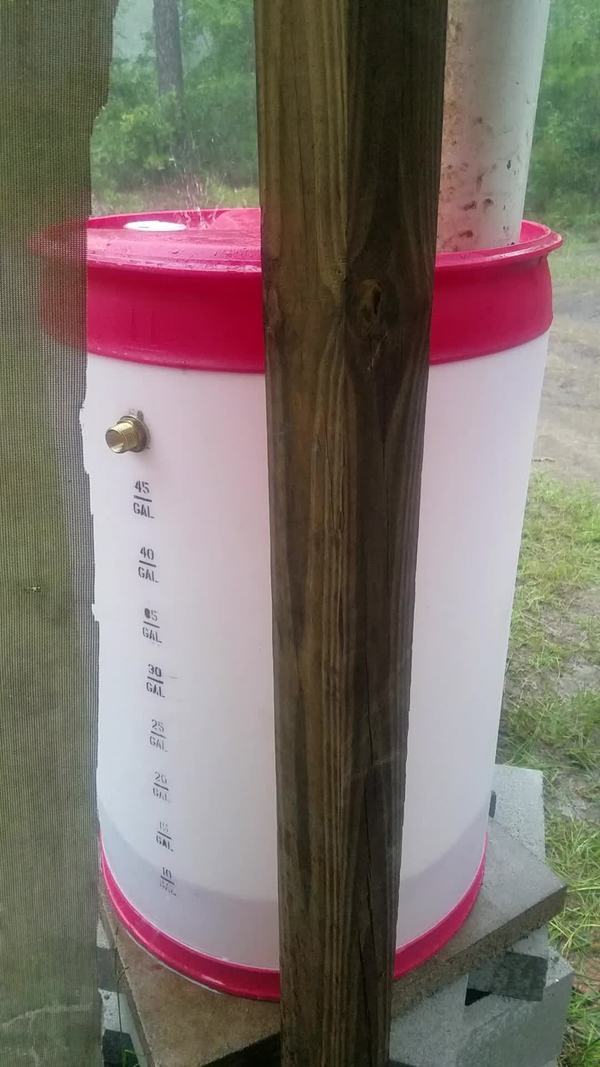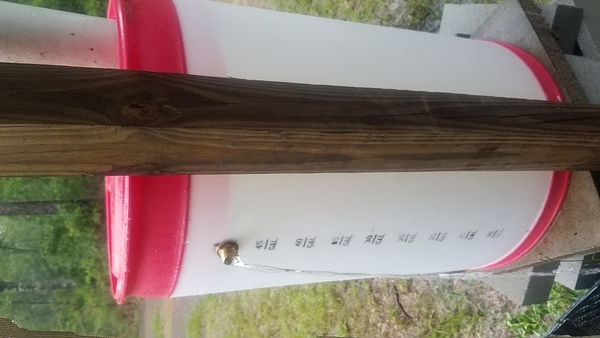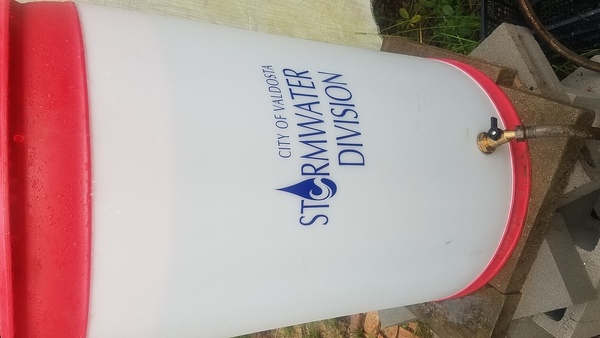Gretchen picked up a rainbarrel when she stopped by the Valdosta City Hall Annex to drop off okra (Okra Paradise Farms has customers everywhere).
Here’s a video of it filling up:
Rainbarrel from Valdosta Stormwater 2018-07-20
Video by John S. Quarterman for Lowndes Area Knowledge Exchange (LAKE),
at Okra Paradise Farms, Lowndes County, Georgia.
Gretchen posted some longer videos on facebook. It took about 20 minutes for that 50-gallon rainbarrel to fill. Here it is pouring out of the overflow:
You could chain more of these together, overflow to input.
This rainbarrel filled up quickly from about 325 square feet of roof, with a very leaky raingutter. Your house roof is probably much larger than that. (We already use much of the water from the rest of our farm workshop roof for other purposes.)
This rainbarrel from the city of Valdosta has a screen over its intske to keep out leaves. A few concrete blocks to hold it up, a piece of PVC pipe to feed it from a roof gutter: instant rainwater collection!
Within an hour we had a hose hooked up and we used some of the water in transplanting plants (banana and citrus trees).
That’s the real reason for the concrete blocks: to hold the rainbarrel up high enough to get some gravity outflow.
Interesting tip about olive oil in this writeup of the event at which Gretchen got the rainbarrel. These lunch and learns are free. You get to assemble your rainbarrel and take it home, all for free. Ashlyn Becton, PR, City of Valdosta, 16 July 2018, “Make & Take” Rain Barrel Lunch and Learn informs citizens on ways to conserve water,
On Friday July 13, The City of Valdosta Stormwater Division held a “Make & Take” Rain Barrel Lunch and Learn to inform citizens about the use of Rain Barrels as a simple and inexpensive way to conserve water and reduce runoff.
City staff taught citizens how to build, install, and maintain rain barrels, which can be used to collect and store rainwater from roofs. This lunch and learn was held in the City Hall Annex Multi-Purpose Room. The participants each built their own rain barrels with the help of city staff members. The lunch and learn taught different ways of how the rain barrels can be used to water plants in their homes and gardens. One inch of rain on a 1,500 square foot roof equates to an estimated 935 gallons of water. All of the tools, materials, and lunch were provided to participants free of charge.
Tips & Information from the City of Valdosta Stormwater Division :
• Make sure your rain barrel is sitting level. Water is heavy (about 8 lbs/gal)!
• Water should not be stored for extended periods of time.
• Control mosquitoes by adding 1 tbsp. of olive oil.
• Clean the barrel twice a year.
• Raise rain barrel to increase pressure.
• Do not use rain barrel water for cooking or drinking!
People interested in making a rain barrel can find building and installation instructions at valdostacity.com/education-outreach or call (229) 259-3530.
This is at least the second year Valdosta has done this. Kimberly Cannon, Valdosta Daily Times, 1 June 2017, Residents construct free rain barrels,
Angela Bray, stormwater manager, provided instructions on how to build the rain barrels, and Mike Pieper, city marshal, and Scott Nobles, stormwater supervisor, helped with drilling holes in the barrels.
Thanks, Angela, for the rainbarrel already pre-built!
And apparently at least the third year, since here are Angela’s slides from 2016.
The state of Georgia publishes a guide for collecting rainwater: Georgia Rainwater Harvesting Guidelines, Georgia Department of Community Affairs, 2009. That guide is all about rainwater for watering gardens, washing cars, flushing toilets, and such. It repeatedly emphasizes non-potable water.
If you want to drink your rainwater, that requires some filters to get rid of bacteria and maybe an ultraviolet (UV) light to get rid of viruses. Or chlorine. That guide mentions all those things, but carefully never talks about using rainwater for drinking water.
I can tell you it can be done, but carefully. Somewhere around here I have slides on how we do it.
But it’s much easier to collect and use rainwater for non-potable purposes.
It’s raining as I post this, and the rainbarrel is full again!
-jsq
Investigative reporting costs money, for open records requests, copying, web hosting, gasoline, and cameras, and with sufficient funds we can pay students to do further research. You can donate to LAKE today!
Short Link:


